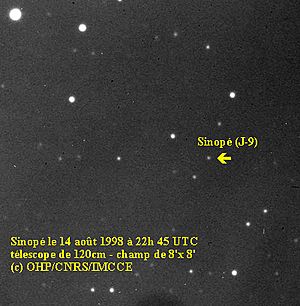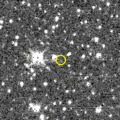Sinope (moon) facts for kids
 |
|
| Discovery | |
|---|---|
| Discovered by | S. B. Nicholson |
| Discovery date | July 21, 1914 |
| Orbital characteristics | |
| Periapsis | 18,237,600 km |
| Apoapsis | 30,191,200 km |
|
Mean orbit radius
|
23,540,000 km |
| Eccentricity | 0.25 |
| 724.1 d (1.95 a) | |
|
Average orbital speed
|
2.252 km/s |
| Inclination | 128.11° (to the ecliptic) 153.12° (to Jupiter's equator) |
| Satellite of | Jupiter |
| Physical characteristics | |
|
Mean radius
|
~19 km |
| ~4500 km2 | |
| Volume | ~28,700 km3 |
| Mass | 7.5×1016 kg |
|
Mean density
|
2.6 g/cm3 (assumed) |
| 0.014 m/s2 (0.001 g) | |
| ~0.023 km/s | |
| Albedo | 0.04 (assumed) |
| Temperature | ~124 K |
Sinope is a non-spherical moon of Jupiter. It was found by Seth Barnes Nicholson at Lick Observatory in 1914, and is named after Sinope of Greek mythology.
Sinope did not get its present name until 1975; before then, it was simply known as Jupiter IX. It was sometimes called "Hades" between 1955 and 1975.
Sinope was the farthest known moon of Jupiter until the discovery of Megaclite in 2000. The farthest moon of Jupiter now known is S/2003 J 2.
Orbit
Sinope orbits Jupiter on a high eccentricity and high inclination retrograde orbit. The orbital elements are as of January 2000. They are changing a lot due to Solar and planetary perturbations. It is often believed to belong to the Pasiphaë group. However, given its mean inclination and different colour, Sinope could be also an independent object, captured independently, unrelated to the collision and break-up at the origin of the group. The diagram illustrates Sinope's orbital elements in relation to other moons of the group.
Physical characteristics
Sinope has an estimated diameter of 38 km (assuming an albedo of 0.04) The moon is red unlike Pasiphae which is grey.
Its infrared spectrum is similar to D-type asteroids also different from Pasiphae. These dissimilarities of the physical parameters suggest a different origin from the core members of the group.
Images for kids
See also
 In Spanish: Sinope (satélite) para niños
In Spanish: Sinope (satélite) para niños



